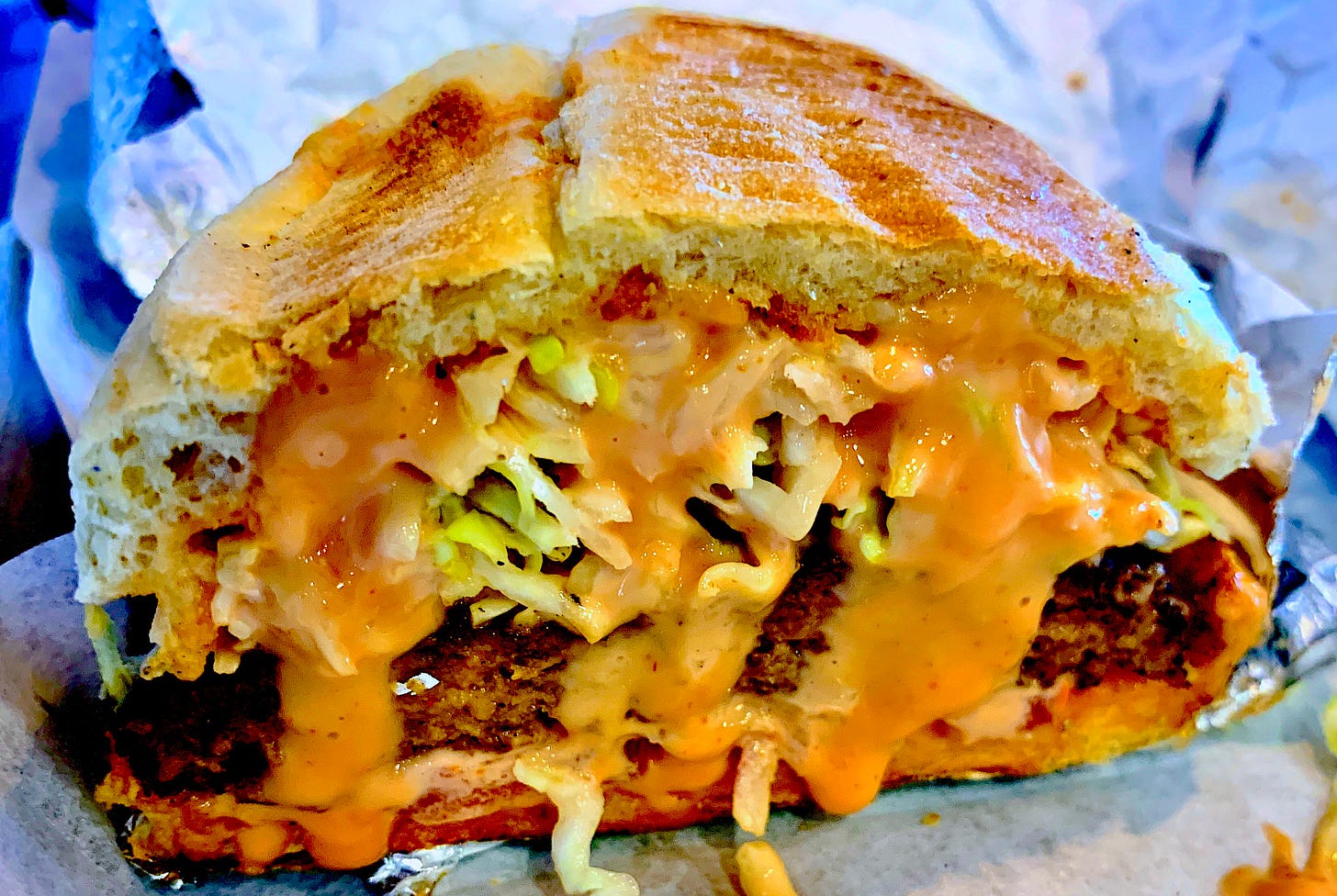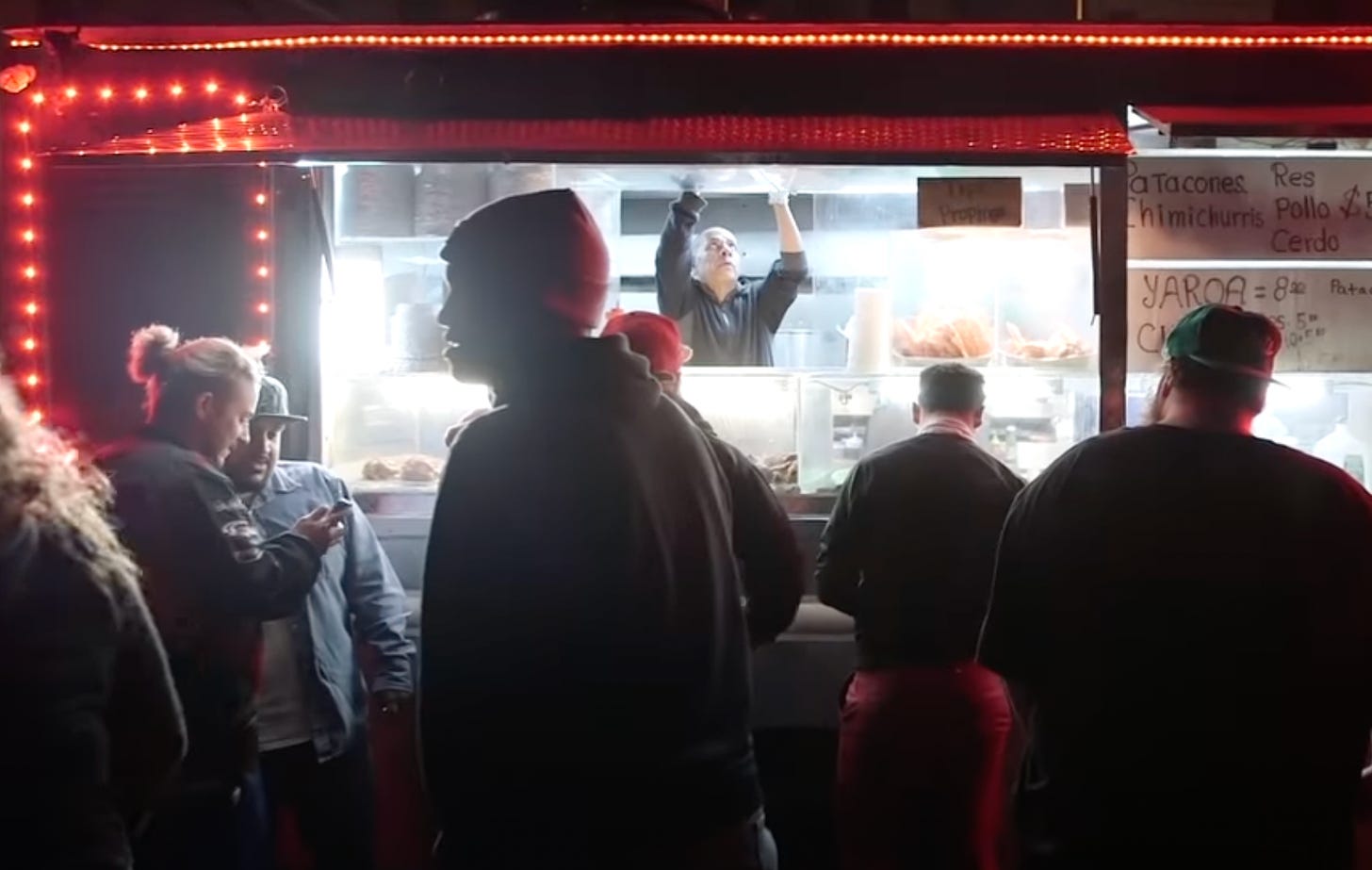Notable Sandwiches #39: The Chimichurri Burger
How "The Dominican Big Mac" became a New York favorite
Welcome to Notable Sandwiches, the series in which we trip merrily through the profoundly odd and ever-changing document that is Wikipedia’s List of Notable Sandwiches. Once I meet a book deadline at the end of the month, I’ll be back on the sandwich beat. But for now, David writes about a late-night Dominican staple: the chimichurri burger, or “chimi.”
— Talia
“Puffing cheeba in the street by the chimi corner/Tu no ta pa mi, muthafuckas are sloppy/Captain of the rap, you talking to papi” — Action Bronson, “Shiraz”
When he was growing up in an Albanian immigrant household in Queens—before he started working in the kitchen of his father’s restaurant, before he went to culinary school in Manhattan, and long before he achieved stardom as a rapper and food personality—Action Bronson didn’t know what a real hamburger was. In his book F*ck, That’s Delicious, the MC (born Ariyan Arslani) describes the childhood epiphany—familiar to so many immigrant kids in America—that the “hamburgers” he was getting at home weren’t hamburgers at all. “I came to realize that I was lied to as a child, and what they were making me was an Albanian dish called çevapi,” he writes. “I didn’t know that a hamburger was a hamburger until I got a real one years later, because my hamburgers always came with mad shit in it”—onions, parsley, garlic, spices. “You can’t call it a burger when you do that. You have to it something else, like çevapi, or a chimi.”
The chimi, or “chimichurri burger,” falls into a subcategory of sandwich at which New York City excels. While, as I argued last week, Los Angeles may be “the hamburger capital of the world,” the truth is that numerous cultures have their own versions of ground-meat patty sandwiches. In this series, Talia has already desribed the bun kebab (aka, Pakistan’s “poor man’s burger”), and in the months ahead we’ll be addressing China’s “donkey burger,” Singapore’s “har cheong gai burger,” and Afghanistan’s “Kabuli burger.” Not on the list of notable sandwiches (but present elsewhere on Wikipedia) you can find regional variations of the hamburger like Denmark’s “bøfsandwich,” Serbia’s “pljeskavica,” or, yes, the Balkan “ćevapi.” To this we can now add the “chimi,” a sandwich Action Bronson calls “the Dominican Big Mac.”

A staple of late-night food trucks from Santo Domingo, D.R., to Providence, R.I.—basically, anywhere the Dominican diaspora has reached—the chimi is a simple dish. Seasoned hamburger patties are cooked on a grill, stuffed into a crusty pan de aqua roll, topped with shredded cabbage, maybe some chopped onions, and smothered in “chimi sauce”—which is nothing at all like the herbaceous, green Argentine chimichurri, and is instead something called salsa golf, which is closer to Russian or Thousand Island dressing. The meat seasoning seems to be the primary characteristic that distinguishes one chimi from another. Recipes online call for a variety of flavorings, including oregano, adobo, garlic, Worcestershire or soy sauce, salt, pepper, and Goya “sazon” seasoning—a surfeit of ingredients that makes the chimi sound something like a cooked steak tartare. What sets the chimi apart is the fact that—despite those basic guidelines—no two recipes are the same.
As any fan of Cardi B, Junot Diaz, Manny Ramirez, or Lin Manuel-Miranda’s “In The Heights” knows, New York City is home to a vibrant Dominican community, centered in the vertiginous northern reaches of Manhattan. Historically speaking, this is a fairly new development. While the city’s Puerto Rican population goes back to the nineteenth century, the Dominican wave is a more recent phenomenon, ignited by the fall of the brutal Trujillo regime in the 1960s. But New York has actually had a Dominican presence, if a modest one, for more than 400 years.
The Sword and the Sandwich is a newsletter about serious extremism and equally serious sandwiches. Please consider supporting this work with a paid subscription:
In 1613, a dozen years before the New Amsterdam colony was established on the southern tip Manhattan island, an Afro-Latino sailor named Juan Rodriguez (also know as “Jan Rodrigues” and “João Rodrigues”) became the first non-native resident of what we now call New York City. Born in the Spanish colony of Santo Domingo on the island of Hispaniola in the Caribbean, Rodriguez had accompanied the Dutch ship “Jonge Tobias” up North America’s eastern seaboard, and decided to stay behind on Manhattan when the crew departed. According to legal documents at the time, Rodriguez—the “mulatto” or “Spaniard”—had “run away from the ship and gone ashore,” and then refused accompany the vessel to Holland.
Instead, Rodriguez established a small trading post, befriended the local native population, and may even have married a Lenape wife. According to Ramona Hernandez of the Dominican Studies Institute at the City College of New York, we can safely declare Rodriguez, “the first immigrant, the first black person, the first merchant, the first Latino and, to us, the first Dominican to have ever lived in New York City.” In October, 2012—almost 400 years after Rodriguez’s decampment—the mayor of New York renamed a portion of Broadway at the northern tip of Manhattan “Juan Rodriguez Way.” Today, it’s the spine of the city’s Dominican community, by some estimates the largest immigrant population in all of New York.
That history may help explain the popularity of the chimi in the city, but it doesn't tell us anything about why a street-burger with ketchup-mayo sauce shares a name with an iconic South American condiment. As is the case with so many of the sandwiches on the Wikipedia list, the origin of the chimi is murky. One thing that it decisively is not—despite the name—is a hamburger covered in what most of us know as chimichurri sauce. (Made with parsley, garlic, oil, vinegar, oregano, salt and pepper, this chimichurri sauce is wonderful, and I highly recommend it with various grilled meats and sausages.) According to legend, an Argentine immigrant named Juan Abrales moved to the Dominican Republic in the 1970s, opening a street cart where he began selling traditional-chimichurri dressed “choripanes,” or sausage sandwiches. He called these “chimichurris,” and soon other enterprising cooks took note, took the name, and started selling versions of their own.
A half century later—and over four centuries after Juan Rodriguez first brought proto-Dominican culture to New York—the chimi has become a late night city staple like the utility pizza slice, takeout Chinese order, or foil-wrapped chopped cheese. These days, in the early hours of the morning—after the salsa clubs have begun disgorging their dancers—the streets around Juan Rodriguez Way begin to ripple with hungry revelers crowded around converted ice cream trucks with their digital signs flashing the word: “CHIMI.” Action Bronson is a regular. In his salad days, he’d come to the neighborhood to buy weed, and then hit La China on Amsterdam Avenue, a chimi truck where they press and toast the roll until you can “hear the crispness when you tap it with your finger.” Bronson has taken a Vice camera crew to sample the chimi at La China, raved about it in the New York Post, and included an ode to its offerings in his book. But, as we’ve established, Bronson is pretty particular about his burgers, and as much as he loves the offering at La China, it does have mad shit in it. So don’t call it a burger—it’s a chimi.







